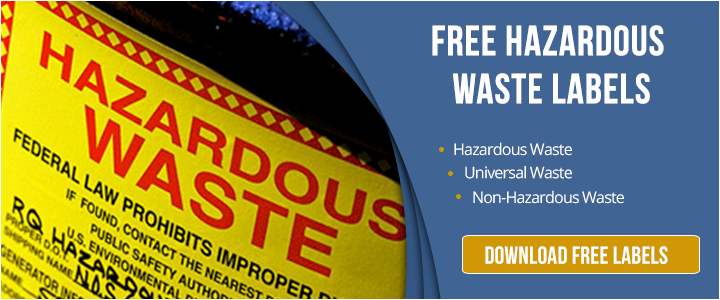When filling out hazardous waste signs labels, you must follow a set of guidelines that have been put into place by federal and state regulatory agencies. These guidelines include:
- Labeling each container with the words, “Hazardous Waste”
- Recording the accumulation date
- Recording information about the substance
- Providing shipping information
- Incorporating EPA requirements
Below we’ll explore these requirements so that, as a hazardous waste generator, you can ensure your company is meeting all hazardous waste label requirements.
Include The Words, ‘Hazardous Waste’
Perhaps the most important part of a hazardous waste label or sign is that it must say “Hazardous Waste” on it. Avoid any label or sign that simply says “waste” or only features the name of the substance inside the container.
While that is useful information, per the California Department of Toxic Substances Control (DTSC), the tank or container that is holding the waste must be labeled or clearly marked with the words, “Hazardous Waste.”
Record The Accumulation Date
 As a hazardous waste generator, you must record the date on the label upon which each period of accumulation begins. Pursuant to Title 22, California Code of Regulations, this date must be clearly marked and visible for inspection on each accumulation unit.
As a hazardous waste generator, you must record the date on the label upon which each period of accumulation begins. Pursuant to Title 22, California Code of Regulations, this date must be clearly marked and visible for inspection on each accumulation unit.
There are a couple important points to remember regarding what the DTSC requires for accumulation dates:
- Containers and tanks used by the generator to collect or consolidate wastes initially accumulated in other containers are subject to the same labeling requirements.
- The initial accumulation and “90-day period” dates on the “collection” container must be the oldest of the initial accumulation. This may require dates to be changed if wastes from older containers are added to the collection container.
- If containers are continuously reused for accumulation of the same waste stream, “recurring use” labels may be used on these containers to revise the initial accumulation and “90-day period” dates (without having to change the other labeling information). If the container is emptied at least once each day, the word “daily” may be used in the date area of the label.
Include Information About The Substance
On your hazardous waste label, the DTSC requires you to include the following information about the substance that is inside the container:
- The composition and physical state of the waste
- A statement or statements that call attention to the particular hazardous properties of the waste (if it’s flammable, reactive, etc.)
The U.S. Department of Transportation (DOT) also requires that you include a diamond hazard label for the primary (and most subsidiary) hazard classes of the hazardous material.
Provide Shipping Information
 The DTSC requires that each hazardous waste label include the name and address of the generator.
The DTSC requires that each hazardous waste label include the name and address of the generator.
For shipments of hazardous material, the DOT also requires that each non-bulk package (maximum capacity no more than 119 gallons) to display, at a minimum:
- The proper shipping name and identification number of the hazardous material
- The name and address of the shipper and/or the designated recipient
Incorporate EPA Requirements
While the above requirements cover nearly all areas of filling out hazardous waste labels, the U.S. Environmental Protection Agency also requires that the generator “mark each hazardous waste container with a capacity of 119 gallons or less with the following words and information”:
HAZARDOUS WASTE - Federal Law Prohibits Improper Disposal. If found, contact the nearest police or public safety authority or the U.S. Environmental Protection Agency.
Generator’s Name and Address _____________.
Generator’s EPA Identification Number __________________.
Manifest Tracking Number ___________________.
Don’t Forget These Important Tips
In addition to the requirements we outlined above, it is important to keep in mind a few other tips for properly filling out hazardous waste labels.
- All personnel should use the same method when filling out a hazardous waste label. In other words, all labels should either be handwritten, prepared electronically or prepared using another method.
- Make sure all waste handlers are properly trained and know what the markings mean.
- Before reusing containers, make sure all old markings or labels are washed off or completely blacked out.
Even when labels are properly filled out, they must be properly displayed as well so handlers do not miss this important information. For example:
- Labels must appear in their entirety and not covered up by any other markings.
- They should not be placed near any other markings.
- Labels should always be visible, so never place them on the bottom of a container.
- If the waste has multiple hazards associated with it, multiple labels should be displayed next to each other. The DOT recommends a six-inch space between labels.
- The label designated as the primary hazard should be above and to the left of the label designating the subsidiary hazard.
Need Labels?
While label requirements are regulated, the labels themselves are not. Therefore, you can use any label that meets the requirements above.
However, while several sites offer pre-printed labels, these can be costly and inconvenient, especially if you need the labels quickly. You can help ensure compliance right away, however, by downloading IDR’s free hazardous waste labels for your storage containers.
These labels are compliant with EPA, DOT and DTSC regulations and can be simply downloaded and printed.
There are several other online sites that offer free labels as well, but it is important that with any download or purchase, that you ensure the labels are compliant so that your company is following all necessary regulations and maintaining the highest level of safety in your workplace.


Comment